The Economic Value of the National Parks
Air Date: Week of October 18, 2019
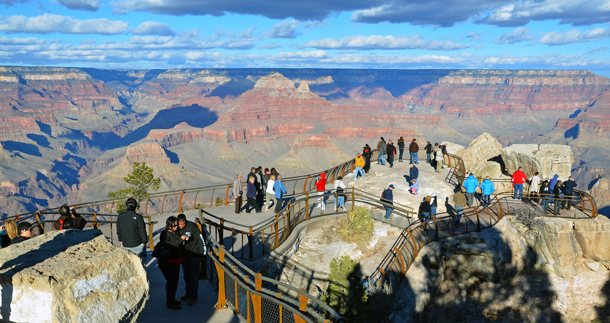
Funding for the National Park service has remained flat for decades despite a steady rise in visitors from 200 million in 1980 to 330 million in 2018. (Photo: Grand Canyon National Park, Flickr CC BY 2.0)
The National Parks have been famously called “America’s Best Idea,” but they may also be “America’s Best Investment”, thanks to the valuable services they provide such as recreation, carbon storage, and educational programs. In the new book "Valuing U.S. National Parks and Programs," John Loomis and Linda Bilmes attempt to sum up the vast value of the National Parks. Linda Bilmes teaches Public Policy at the Harvard Kennedy School, and joins Host Steve Curwood in the Living on Earth studios.
Transcript
CURWOOD: The National Parks have been famously called “America’s Best Idea,” but they may also be “America’s Best Investment”, thanks to the valuable services they provide such as recreation, carbon storage, and educational programs just to name a few. In the new book "Valuing U.S. National Parks and Programs," John Loomis and Linda Bilmes attempt to sum up the vast value of the National Parks. Linda Bilmes teaches Public Policy at the Harvard Kennedy School, and she joins me now in the Living on Earth studios. Linda, welcome back to Living on Earth!
BILMES: Thank you.
CURWOOD: So what makes the national parks and programs "America's best investment"?
BILMES: We call them America's best investment because Americans treasure the national parks both for the recreational spaces they provide, for the historical places they, that they curate, for the watersheds and ecosystems they protect. And yet we invest a very, very small amount of money in these treasures. So when we looked at them carefully, and we tried to understand, well, what is the value of protecting the national parks, we found that the value is at least 100 billion dollars, which is a 30 times multiple of what the federal government actually spends on the national parks each year.
CURWOOD: So the National Park Service gets about three billion dollars, two or three billion dollars a year?
BILMES: Well, the national parks are funded through a very complex formula, but overall, over the last 20 years, their funding has been flat at the same time that the number of visitors in the parks has increased by about 50%. So they get about, from the federal government, they get about two and a half to three billion dollars a year. And they get some money from private philanthropy and they get some money from concessionaires. But overall, they're operating on a shoestring.
CURWOOD: For something that's worth 100 billion dollars, you say.
BILMES: Well, for something that on a very conservative basis is worth 100 billion dollars. And what we did in the book, and in the study over the past 10 years is we tried to put a price on something that is, in many ways, priceless. But we tried to use standard economic techniques to figure out, if we did try to understand and estimate the value of protecting these places, what would the American people actually say? What would they be willing to pay in additional taxes to not lose these treasures? And we found that at a very conservative level, that figure was 100 billion dollars, at least.
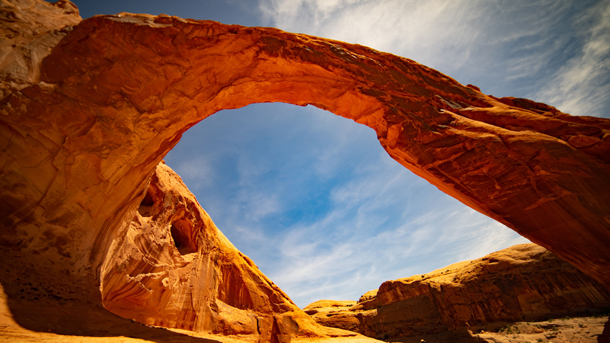
The National Park system protects unique features like Corona Arch in Arches National Park, Utah. (Photo: Tom Gainor, Unsplash)
CURWOOD: So throughout your book, there are these constant reminders that the national park system and the associated programs contribute to society in ways that we just don't really realize. Remind us of those underappreciated contributions that we get from the parks.
BILMES: Well, we went through in our book a number of ways that the national parks create value. And some of them are, are things you, you could think of, like ecosystem services, for example; they sequester carbon, they are, some of the national parks are carbon sinks. They also protect watersheds, they protect wildlife, they generate a lot of tourism dollars. And they also, however, do a few other things that don't immediately come to mind. So one of the interesting chapters in our book, is where we talk about the importance of the national parks in the US movie and TV industries. There have been thousands of blockbuster films that have been filmed in the national parks -- thousands.
CURWOOD: Your favorites?
BILMES: Well, I mean, I have to admit, I am a Star Wars fan.
CURWOOD: [LAUGHS]
BILMES: And the Star Wars Tatooine was filmed in Death Valley. And we interviewed some people who had been involved with Lucasfilm, and they talked about how they chose it, and how it was a place that really looked like it was another planet.
And they also didn't have to worry when they were filming there about having a McDonald's arch in the background, because it was protected. But I also am a fan of the, the redwoods, where ET was filmed, and Forrest Gump, which was filmed on the National Mall, which is a park. So I think that the sort of iconic films have a value, and what we tried to do is to look at and break down that value. So there are values like the fact that the national parks protect certain iconic places. So for example, in the Planet of the Apes when they come back and they see the Statue of Liberty, you don't have to say anymore. It's an icon. Now, that's protected by the National Park. So we try to just introduce the fact that this is one of the most successful industries in the United States. And actually, the National Parks plays a role, even though they don't derive any money from this service.
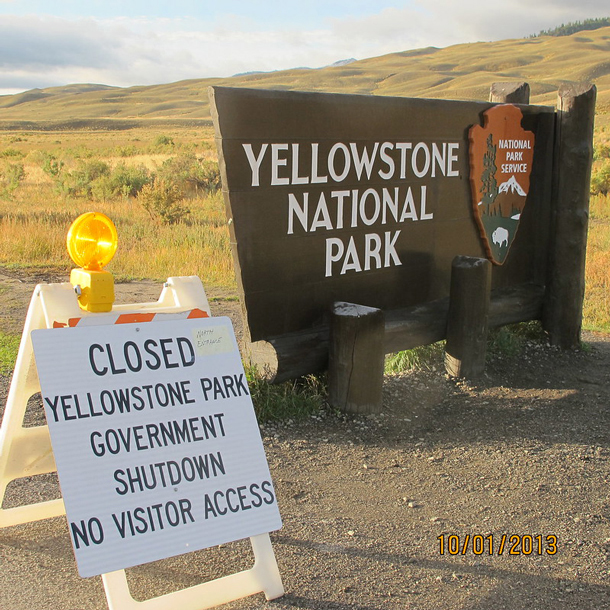
Parks including the treasured Yellowstone National Park have been shuttered during multiple government shutdowns in recent years. (Photo: National Parks Conservation Association, Flickr CC BY-ND 2.0)
CURWOOD: I understand there's a maintenance backlog in the National Park Service of, what, 12 billion dollars? And you point out in your book that the current funding mechanisms just aren't sustainable. So you propose strategies like setting up a national parks endowment. Why would that help ensure that the National Park Service can carry out its, its mission in the generations to come?
BILMES: Well, the National Parks has a very interesting mission. The mission is to protect these special places in perpetuity, in pristine condition, for the enjoyment and recreation of the public. So it's a dual mission, both to protect these places in perpetuity, and to protect them so that people can go visit them and have recreational opportunities in them. And that means you can't just protect them by kind of shutting people out; the whole purpose is to protect them for people's enjoyment. So there's a fundamental disconnect, a misalignment, between the goal of the parks, which is this perpetuity kind of goal and mission, and the way that we fund the parks, which is on a very annual basis where we fund just the operational salaries. And what we have been falling behind on is investing all these long term assets. So maintaining the roads, maintaining the trails, maintaining the parking lots, maintaining the visitor centers, investing in the forests, investing in making sure that firefighting prevention is up to date -- all of these things just keep falling further behind because we've just been sort of funding the, the minimum of the operational needs year to year.
CURWOOD: And there's nothing like a government shutdown to make funding even crazier. Now, let's break down some of the suggestions you have to make the funding of the parks consistent. First of all, an endowment. What would that be? How do you envision an endowment working?
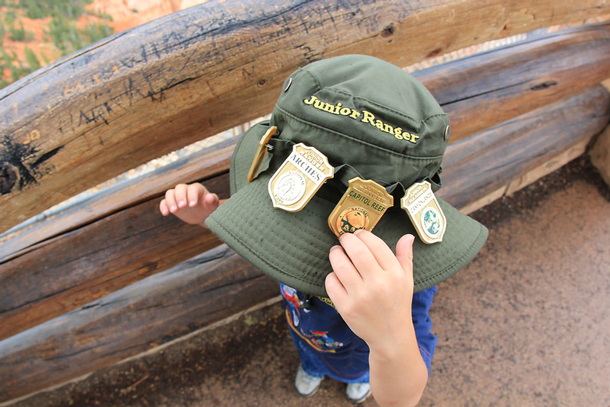
The National Park Service’s Junior Ranger program provides kids with the opportunity to learn more about the national parks. (Photo: daveynin, Flickr CC BY 2.0)
BILMES: When I served on the Second Century Commission, I served with a number of luminaries, including Sandra Day O'Connor and civil war historian, Pulitzer Prize winner James McPherson, and many others. And we spend a year thinking about the fact that we are now celebrating the centennial of the National Parks and thinking, isn't it great that 100 years ago, we had this great idea, which has now been adopted throughout the world of protecting these places. And we tried to think, 100 years from now, what can we do today that we will look back on and think, Oy, we are so glad that 100 years ago we had that idea. And one of the things that we thought about was the funding structure, that if we could figure out a way to make the funding sustainable for the next century, that would be a great thing to do. So we looked at what is the way that organizations with a long term mission create sustainable funding? So organizations like universities have endowments. Many organizations like museums, and hospitals have endowments, and these are a mechanism for enabling an institution to prepare for and fund the long term.
CURWOOD: So Linda, institutions, I'm thinking of the Smithsonian, which is supported in part by federal funding, don't charge for admission. But I think with the exception of the Great Smokies National Park, just about all the big national parks charge a pretty hefty fee per vehicle -- what, 30, 35 dollars? Why do we charge at the gate, how necessary is that, and what does that do for access for people that maybe don't have that much disposable income?
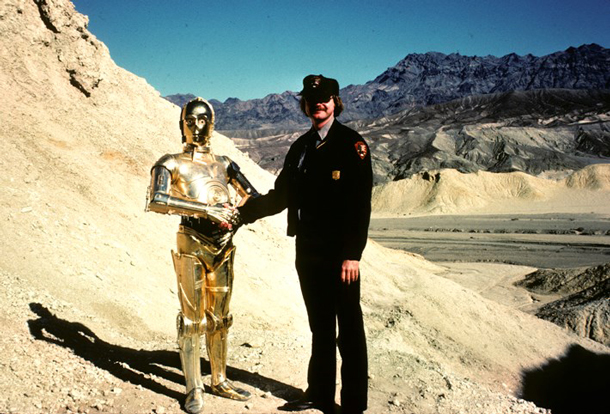
Star Wars, A New Hope, filming in Death Valley. Many iconic movies and TV series have been filmed in U.S. National Parks, at a very low production cost. (Photo: NPS)
BILMES: I think that the question of access to the parks is a really important question. And there are different ways that one could think about it. When you think about the Smithsonian, the Smithsonian Institution is funded partly through a trust, and partly through the federal government. So they have a mixture.
CURWOOD: So that trust is your endowment that you're talking about?
BILMES: Well, it's structured a little bit differently, but I mean, they do have the ability to fund things outside of the federal government funding. Now, the National Park fees overall, there's been a lot of effort to keep them low, to keep entrance fees low. But the fact is that the national parks are in pretty difficult shape right now, in terms of their financial circumstances. You have a situation where, since 1980, we've gone from 200 million visits a year, to 330 million visits last year. At the same time, their budget has remained flat, and the number of requirements and mandates that the national park staff has to do just to keep up has gone up. For example, the amount of fire prevention efforts that they have to do, and the amount of trail maintenance, has increased. But in order to make ends meet, the national parks have cut the number of staff members by 7%. And I think that the public kind of understands that, but all of these numbers are pretty hard to put in perspective. So when I think about the national park budget, and I think about the overall budget, I think, well, the national parks are this incredibly beloved part of the government. People love the parks. And when we were doing our study, when we were first doing this survey, we did focus groups around the country, and I heard people from all over the country talking about how they had emigrated to the US from wherever they had come from -- that they might themselves not be that interested in nature or parks or whatever. But they were so happy that their children had this opportunity to go to the seashore, to go and learn about historical places, to go and to hear this American story in these special places, that they, this was one of the best things about their new country. And yet we are not funding them. And it's not just a matter of giving them a few more dollars every year. It's a matter of aligning the structure of the funding, giving more flexibility to private benefactors and donors and to the national parks themselves, to be able to create a funding structure that is able to keep these places going for the next hundred years.
CURWOOD: You write about perhaps having a multi-year budget cycle for the National Park System. I think a lot of agencies would love to be in a multi-year cycle and not have to put up with the annoying wrestling on Capitol Hill; why should the National Park Service have such an arrangement, do you think?
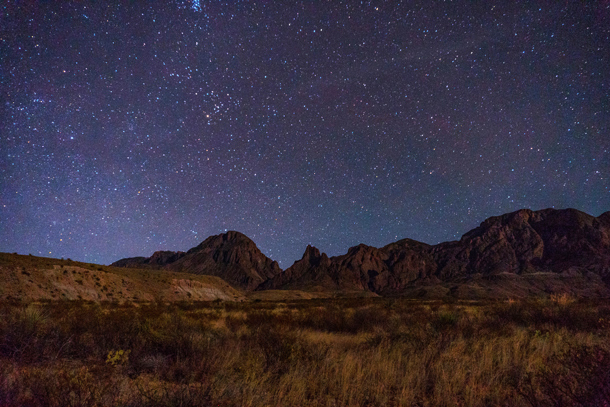
Some National Parks feature excellent night sky viewing. (Photo: David Morris on Unsplash)
BILMES: Well, I believe that there are many agencies in government that should be on a two year cycle rather than a one year cycle. I was very supportive of the Department of Veterans Affairs going to a two year cycle, because they shouldn't be disrupted when they're administering hospitals around the country in the middle of the cycle because Congress can't pass a budget. But the fact that the national parks are so beloved, has made them kind of fair game to be a potato in these government shutdown games. So every time there's a government shutdown, the National Parks has to shut down. And every time there's almost a government shutdown, the National Parks has to prepare to shut down. So you have these places which are all over the country, they take a lot of management because they have visitors, they have facilities, they have all this operational stuff that goes on, and they keep having to either prepare to shut down or shut down, and then they shut down, they have to reopen, they have to reopen the facilities.
CURWOOD: I'm thinking of the most recent set of shut downs, we saw Joshua trees literally getting cut in the Joshua Tree National Park.
BILMES: Well, I think people are extremely indignant because the national parks belong to everybody. And so people from all different walks of life are deciding that they're going to take a vacation, and they're going to go and see the Joshua Tree or they're going to go and see the giant redwood trees that have been around for hundreds of years. Or they're going to go and see those trees at Gettysburg which have got cannonballs embedded in them, that were alive during the Battle of Gettysburg. They're going to go and see this. This is for many people a once in a lifetime trip where they're going to take their children, they've organized themselves to do this. And then because the government can't pass a budget, completely unrelated to anything about the parks, the parks become this political hot potato, this political football, that get shut down. I think it's ridiculous, in general, but I think that one quick fix would be to give the parks a multi-year appropriation.
CURWOOD: In your work you, of course, work closely with a number of economists and scientists and researchers, but you also run into ordinary people when you're out there. Tell me a story of when you were out in one of these national parks, you met somebody and it really, it really inspired you to keep up with this work, which obviously isn't particularly easy.
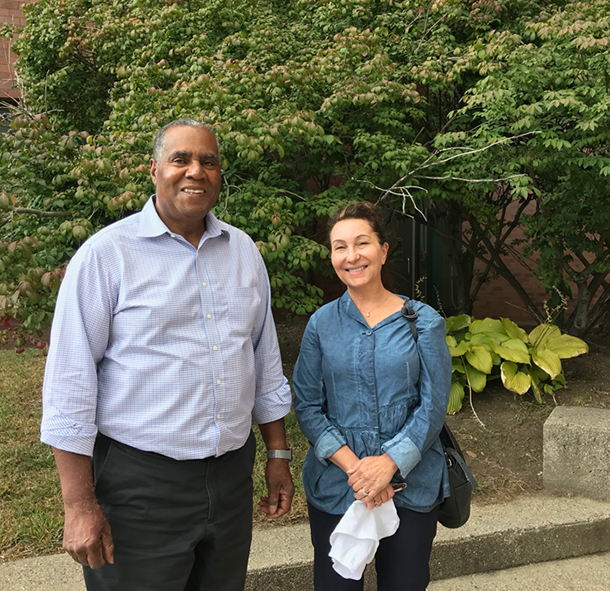
From left, Living on Earth Host Steve Curwood with Professor Linda Bilmes. (Photo: Jenni Doering)
BILMES: I will tell you a story that almost broke my heart. Some years ago when I was serving on the National Parks Advisory Board, we were in the Santa Monica National Recreation Area. And we participated in a trip that the local Los Angeles School District was partnering with the Park Service, with the rangers, in bringing kids to the beach. And these were fifth graders who lived maybe half an hour from the beach. And we got to the beach, and so many of them had never seen the sea. Ever. They were in the fifth grade. And they were kicking off their shoes, and running into the waves. And they were so happy and excited and just joyful with the sea. And it was just incredible because many of them had never been there. And they come from families that have, are working three jobs. They don't have time to bring their kids to the seashore. Or maybe that's not something that they're confident about. And it was just wonderful to see this partnership between the national parks and the schools, bringing these fourth and fifth graders to the sea.
CURWOOD: Valuing U.S. National Parks and Programs was edited by Linda Bilmes and John Loomis. Thank you so much for taking time with us today. Thank you.
Links
Valuing U.S. National Parks and Programs: America’s Best Investment
Learn more about the National Park Service and “Find Your Park”
Living on Earth wants to hear from you!
Living on Earth
62 Calef Highway, Suite 212
Lee, NH 03861
Telephone: 617-287-4121
E-mail: comments@loe.org
Newsletter [Click here]
Donate to Living on Earth!
Living on Earth is an independent media program and relies entirely on contributions from listeners and institutions supporting public service. Please donate now to preserve an independent environmental voice.
NewsletterLiving on Earth offers a weekly delivery of the show's rundown to your mailbox. Sign up for our newsletter today!
 Sailors For The Sea: Be the change you want to sea.
Sailors For The Sea: Be the change you want to sea.
 The Grantham Foundation for the Protection of the Environment: Committed to protecting and improving the health of the global environment.
The Grantham Foundation for the Protection of the Environment: Committed to protecting and improving the health of the global environment.
 Contribute to Living on Earth and receive, as our gift to you, an archival print of one of Mark Seth Lender's extraordinary wildlife photographs. Follow the link to see Mark's current collection of photographs.
Contribute to Living on Earth and receive, as our gift to you, an archival print of one of Mark Seth Lender's extraordinary wildlife photographs. Follow the link to see Mark's current collection of photographs.
 Buy a signed copy of Mark Seth Lender's book Smeagull the Seagull & support Living on Earth
Buy a signed copy of Mark Seth Lender's book Smeagull the Seagull & support Living on Earth

